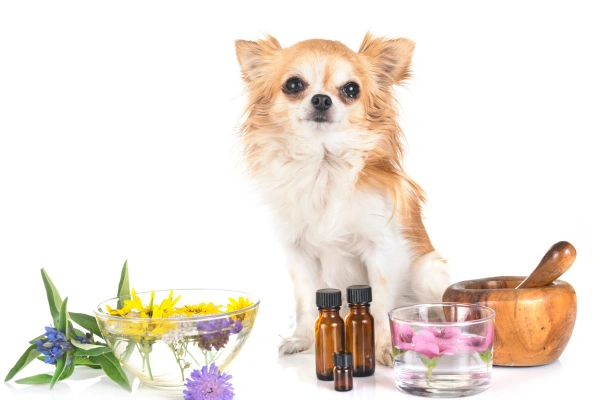Gentle, natural remedies your dog will love—when used the right way!
If you’re a dog parent who prefers natural wellness, chances are you’ve already fallen in love with essential oils. But when it comes to using them around your dog, things can get tricky. Some oils are incredibly soothing, while others can actually be harmful to your pup. The key is knowing which oils are safe and how to use them properly.
So, before you reach for that lavender or tea tree oil, read this. We’re breaking down the best essential oils for dogs, how they help, and how to use them without risking your pup’s health.
Are Essential Oils Safe for Dogs?

Yes—and no. Dogs process smells differently than humans. Their sense of smell is up to 100,000 times more powerful, which means what seems mild to you might be overwhelming to your dog. Some oils are safe when properly diluted. Others should be avoided completely.
Important: Never apply essential oils directly to your dog’s skin without dilution. And don’t let your dog ingest them unless specifically directed by a vet.
The Best Essential Oils for Dogs (And What They Help With)
Here are vet-recommended and dog-safe essential oils, along with their common uses:
1. Lavender – For Anxiety & Relaxation
Lavender is the ultimate calming oil—for humans and dogs alike. It helps reduce anxiety, stress, and even mild pain. Great for thunderstorms, separation anxiety, or travel jitters.
How to use it: Diffuse a drop or two in a water-based diffuser (in a well-ventilated room) or mix 1 drop with 1 tablespoon of carrier oil (like coconut oil) and apply to your dog’s bedding—not their skin.
2. Chamomile – For Calm & Skin Irritation
Gentle and soothing, chamomile oil is perfect for nervous dogs or pups with itchy, inflamed skin. It’s like a cup of herbal tea for their soul.
How to use it: Blend into a homemade paw balm or add a drop to a warm compress for itchy areas (never open wounds).
3. Frankincense – For Immune Support & Inflammation
This ancient oil does wonders for boosting the immune system and calming inflammation. It’s especially helpful for senior dogs dealing with arthritis or general aches.
How to use it: Diffuse it in moderation or add a diluted mix to their collar tag (never directly on fur or skin).
4. Cedarwood – For Flea Repellent & Anxiety
Cedarwood not only smells amazing, it’s also a natural flea and tick repellent. Bonus? It has calming properties too.
How to use it: Add a drop to a homemade flea spray (with water and witch hazel), or dilute and apply lightly to a dog bandana.
5. Ginger – For Motion Sickness
Does your dog get queasy during car rides? Ginger essential oil may help reduce nausea and digestive upset.
How to use it: Diffuse a drop in the car before travel, or let your dog inhale the aroma gently—don’t apply topically.
6. Cardamom – For Respiratory & Digestive Health
This warm, sweet-smelling oil can support healthy breathing and ease tummy troubles.
How to use it: Use in a diffuser or dilute well and apply on your dog’s bedding—not their body.
Essential Oils That Are NOT Safe for Dogs

Avoid these oils completely—they’re known to be toxic to dogs:
- Tea Tree (Melaleuca)
- Cinnamon
- Clove
- Pennyroyal
- Peppermint (in large quantities)
- Wintergreen
- Citrus oils (lemon, orange, grapefruit)
Even small amounts of these can cause symptoms like vomiting, drooling, muscle tremors, and more. If in doubt—leave it out.
Safe Ways to Use Essential Oils for Dogs
Here are four dog-friendly methods for using essential oils:
1. Diffusion
Use a water-based diffuser in a well-ventilated room. Always allow your dog to leave the space if the scent is too strong.
2. Topical (Only When Diluted)
Mix 1 drop of essential oil with 1 tablespoon of a carrier oil like coconut, olive, or almond oil. Apply lightly to your hands and pet your dog, or apply to accessories like bandanas—not directly on the fur or skin.
3. Sprays
Make a DIY calming or flea-repelling spray using essential oils diluted in water and a splash of witch hazel. Always shake before use.
4. Inhalation
Let your dog sniff the cap of the bottle from a distance. This is great for anxiety support before travel or vet visits.
Signs of Essential Oil Toxicity in Dogs
If you notice any of the following after using oils, stop immediately and contact your vet:
- Drooling or vomiting
- Weakness or lethargy
- Trouble breathing
- Tremors or seizures
- Red, irritated skin
Dogs can react differently based on size, age, and sensitivity—start small and always monitor your pup.
Natural Help, When Done Right

Essential oils can be a powerful, natural way to support your dog’s health—but only when used wisely. Stick to dog-safe oils, always dilute properly, and watch your dog’s response. When in doubt, talk to your vet—especially if your dog has existing health conditions.
Your pup deserves the best. And with a little knowledge, you can safely bring nature’s remedies into their world.





